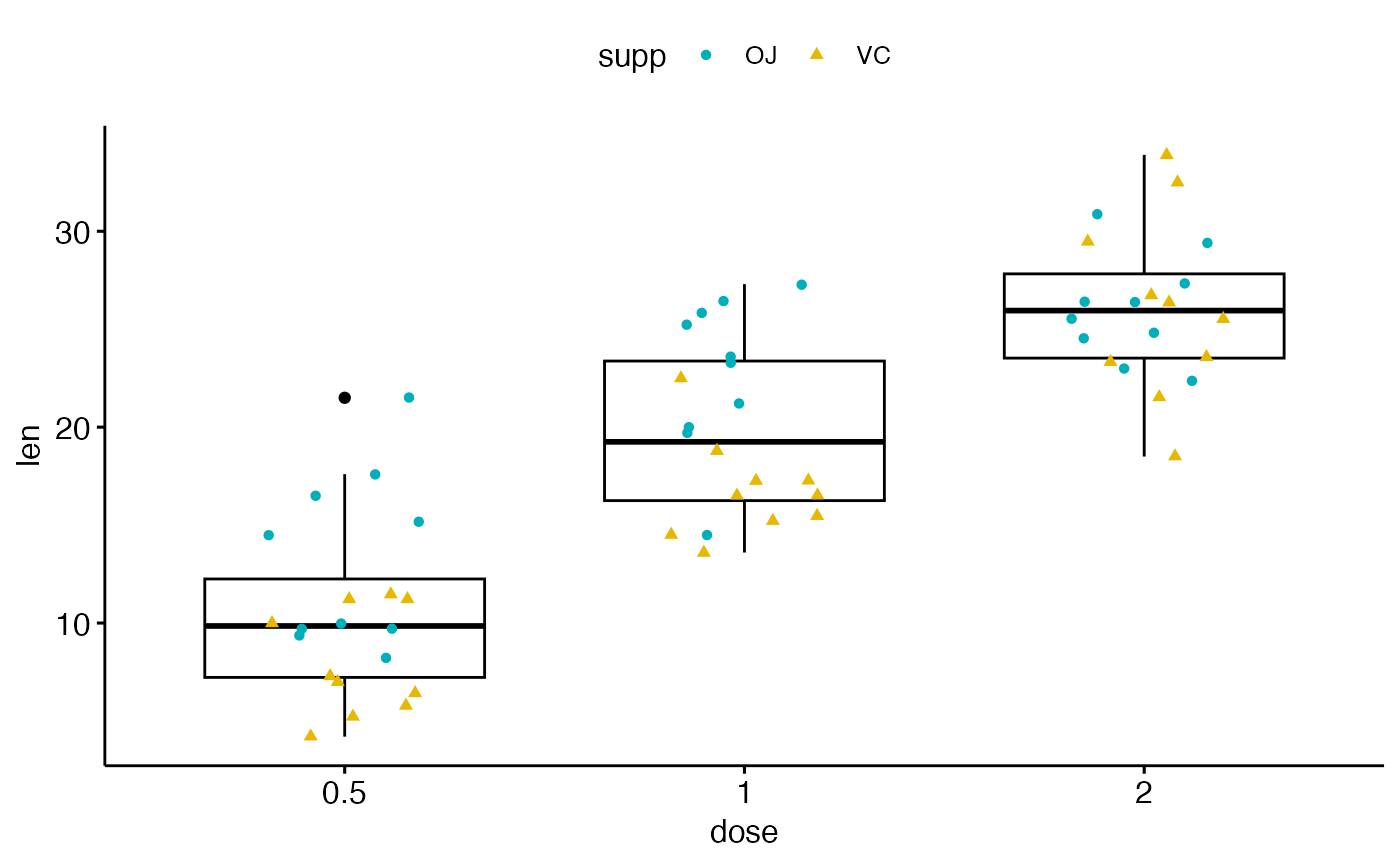Create a stripchart, also known as one dimensional scatter plots. These plots are suitable compared to box plots when sample sizes are small.
ggstripchart(
data,
x,
y,
combine = FALSE,
merge = FALSE,
color = "black",
fill = "white",
palette = NULL,
title = NULL,
xlab = NULL,
ylab = NULL,
facet.by = NULL,
panel.labs = NULL,
short.panel.labs = TRUE,
shape = 19,
size = NULL,
select = NULL,
remove = NULL,
order = NULL,
add = "mean_se",
add.params = list(),
error.plot = "pointrange",
label = NULL,
font.label = list(size = 11, color = "black"),
label.select = NULL,
repel = FALSE,
label.rectangle = FALSE,
jitter = 0.2,
position = position_jitter(jitter, seed = 123),
ggtheme = theme_pubr(),
...
)Arguments
- data
a data frame
- x
character string containing the name of x variable.
- y
character vector containing one or more variables to plot
- combine
logical value. Default is FALSE. Used only when y is a vector containing multiple variables to plot. If TRUE, create a multi-panel plot by combining the plot of y variables.
- merge
logical or character value. Default is FALSE. Used only when y is a vector containing multiple variables to plot. If TRUE, merge multiple y variables in the same plotting area. Allowed values include also "asis" (TRUE) and "flip". If merge = "flip", then y variables are used as x tick labels and the x variable is used as grouping variable.
- color
outline color.
- fill
fill color.
- palette
the color palette to be used for coloring or filling by groups. Allowed values include "grey" for grey color palettes; brewer palettes e.g. "RdBu", "Blues", ...; or custom color palette e.g. c("blue", "red"); and scientific journal palettes from ggsci R package, e.g.: "npg", "aaas", "lancet", "jco", "ucscgb", "uchicago", "simpsons" and "rickandmorty".
- title
plot main title.
- xlab
character vector specifying x axis labels. Use xlab = FALSE to hide xlab.
- ylab
character vector specifying y axis labels. Use ylab = FALSE to hide ylab.
- facet.by
character vector, of length 1 or 2, specifying grouping variables for faceting the plot into multiple panels. Should be in the data.
- panel.labs
a list of one or two character vectors to modify facet panel labels. For example, panel.labs = list(sex = c("Male", "Female")) specifies the labels for the "sex" variable. For two grouping variables, you can use for example panel.labs = list(sex = c("Male", "Female"), rx = c("Obs", "Lev", "Lev2") ).
- short.panel.labs
logical value. Default is TRUE. If TRUE, create short labels for panels by omitting variable names; in other words panels will be labelled only by variable grouping levels.
- shape
point shape
- size
Numeric value (e.g.: size = 1). change the size of points and outlines.
- select
character vector specifying which items to display.
- remove
character vector specifying which items to remove from the plot.
- order
character vector specifying the order of items.
- add
character vector for adding another plot element (e.g.: dot plot or error bars). Allowed values are one or the combination of: "none", "dotplot", "jitter", "boxplot", "point", "mean", "mean_se", "mean_sd", "mean_ci", "mean_range", "median", "median_iqr", "median_hilow", "median_q1q3", "median_mad", "median_range"; see ?desc_statby for more details.
- add.params
parameters (color, shape, size, fill, linetype) for the argument 'add'; e.g.: add.params = list(color = "red").
- error.plot
plot type used to visualize error. Allowed values are one of c("pointrange", "linerange", "crossbar", "errorbar", "upper_errorbar", "lower_errorbar", "upper_pointrange", "lower_pointrange", "upper_linerange", "lower_linerange"). Default value is "pointrange" or "errorbar". Used only when add != "none" and add contains one "mean_*" or "med_*" where "*" = sd, se, ....
- label
the name of the column containing point labels. Can be also a character vector with length = nrow(data).
- font.label
a list which can contain the combination of the following elements: the size (e.g.: 14), the style (e.g.: "plain", "bold", "italic", "bold.italic") and the color (e.g.: "red") of labels. For example font.label = list(size = 14, face = "bold", color ="red"). To specify only the size and the style, use font.label = list(size = 14, face = "plain").
- label.select
can be of two formats:
a character vector specifying some labels to show.
a list containing one or the combination of the following components:
top.upandtop.down: to display the labels of the top up/down points. For example,label.select = list(top.up = 10, top.down = 4).criteria: to filter, for example, by x and y variabes values, use this:label.select = list(criteria = "`y` > 2 & `y` < 5 & `x` %in% c('A', 'B')").
- repel
a logical value, whether to use ggrepel to avoid overplotting text labels or not.
- label.rectangle
logical value. If TRUE, add rectangle underneath the text, making it easier to read.
- jitter
the amount of jitter.
- position
position adjustment, either as a string, or the result of a call to a position adjustment function. Used to adjust position for multiple groups.
- ggtheme
function, ggplot2 theme name. Default value is theme_pubr(). Allowed values include ggplot2 official themes: theme_gray(), theme_bw(), theme_minimal(), theme_classic(), theme_void(), ....
- ...
other arguments to be passed to
geom_jitter,ggparandfacet.
Details
The plot can be easily customized using the function ggpar(). Read ?ggpar for changing:
main title and axis labels: main, xlab, ylab
axis limits: xlim, ylim (e.g.: ylim = c(0, 30))
axis scales: xscale, yscale (e.g.: yscale = "log2")
color palettes: palette = "Dark2" or palette = c("gray", "blue", "red")
legend title, labels and position: legend = "right"
plot orientation : orientation = c("vertical", "horizontal", "reverse")
Examples
# Load data
data("ToothGrowth")
df <- ToothGrowth
# Basic plot with summary statistics: mean_se
# +++++++++++++++++++++++++++
# Change point shapes by groups: "dose"
ggstripchart(df, x = "dose", y = "len",
shape = "dose", size = 3,
add = "mean_se")
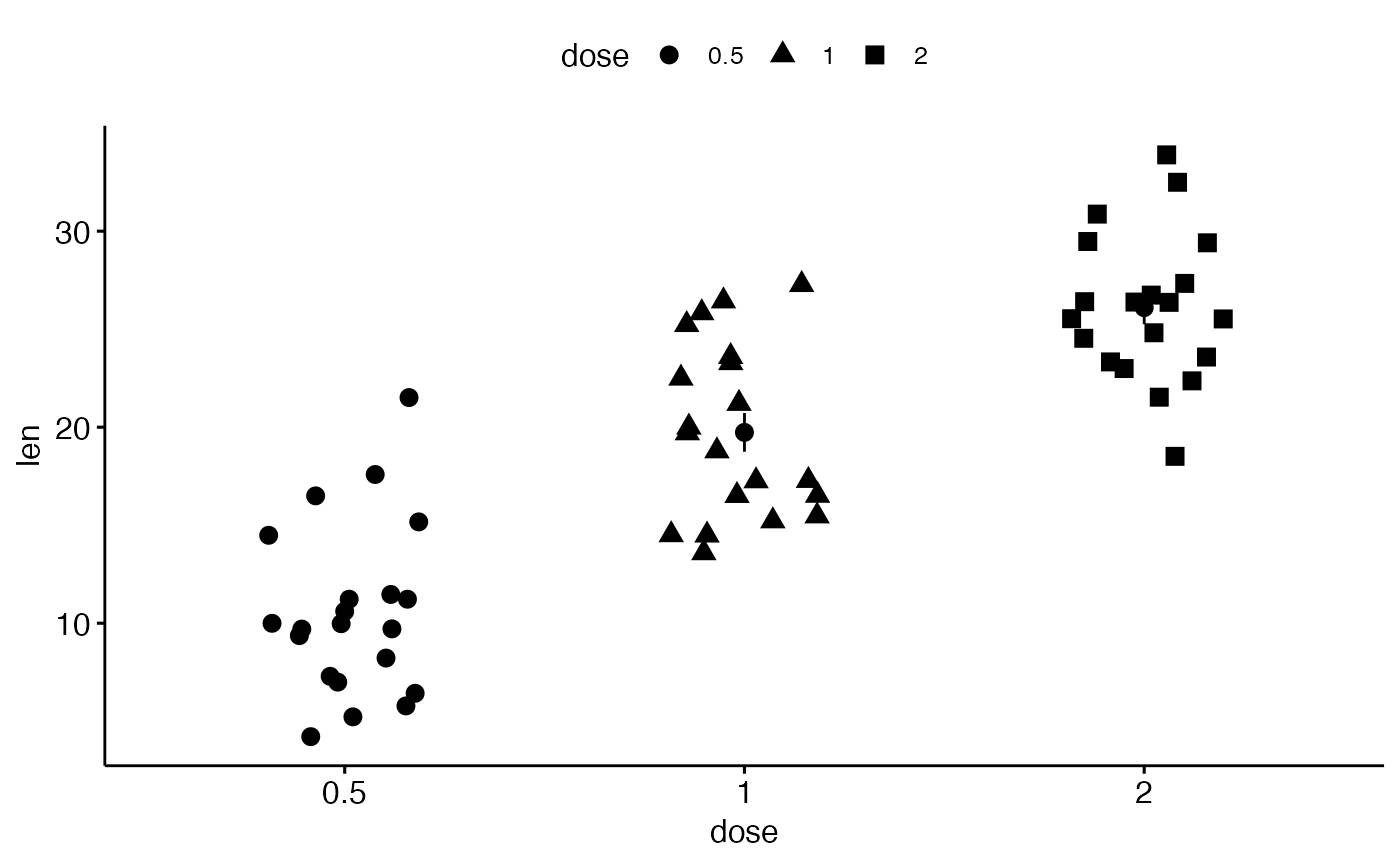 # Use mean_sd
# Change error.plot to "crossbar"
ggstripchart(df, x = "dose", y = "len",
shape = "dose", size = 3,
add = "mean_sd", add.params = list(width = 0.5),
error.plot = "crossbar")
# Use mean_sd
# Change error.plot to "crossbar"
ggstripchart(df, x = "dose", y = "len",
shape = "dose", size = 3,
add = "mean_sd", add.params = list(width = 0.5),
error.plot = "crossbar")
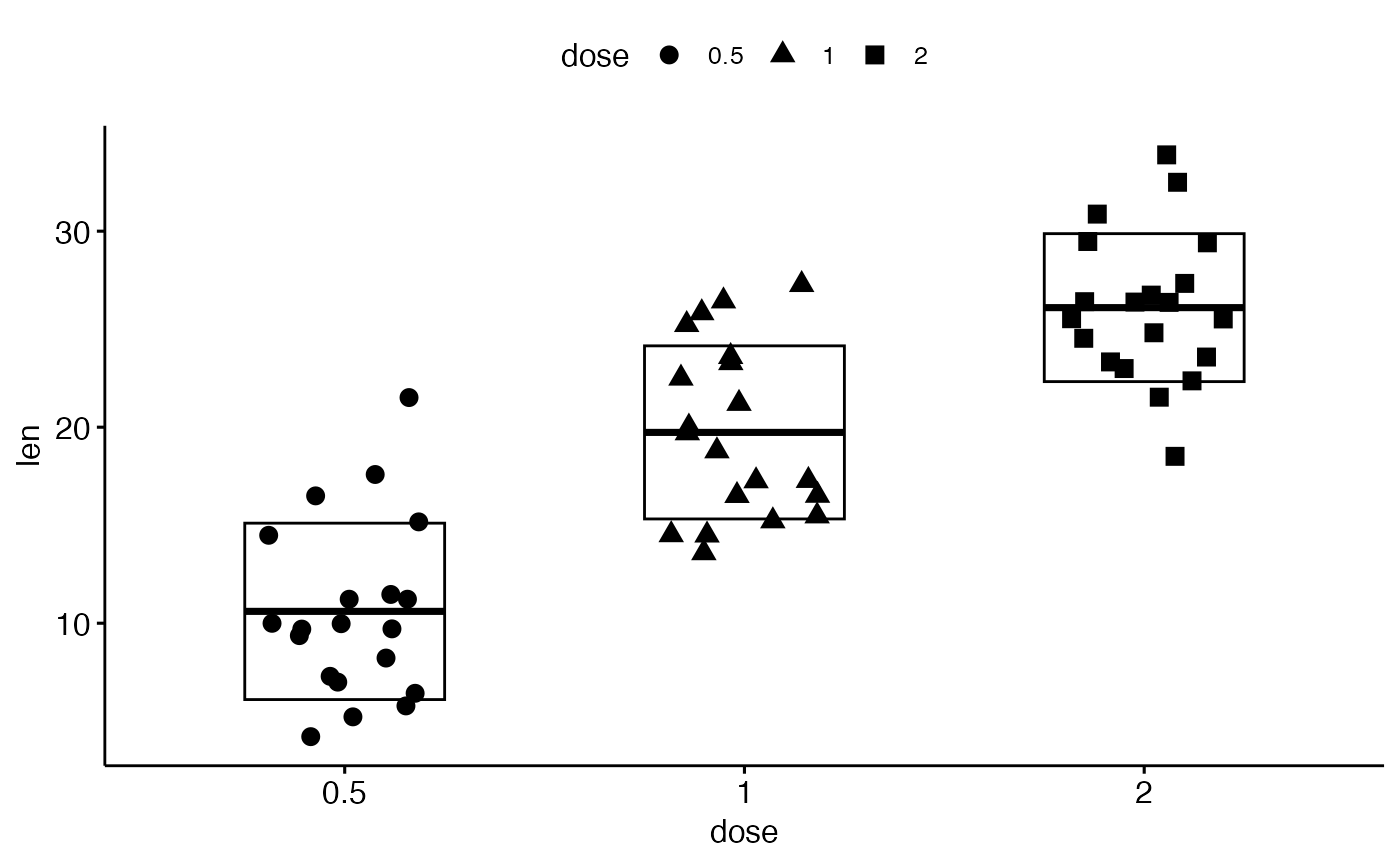 # Add summary statistics
# ++++++++++++++++++++++++++
# Add box plot
ggstripchart(df, x = "dose", y = "len",
shape = "dose", add = "boxplot")
# Add summary statistics
# ++++++++++++++++++++++++++
# Add box plot
ggstripchart(df, x = "dose", y = "len",
shape = "dose", add = "boxplot")
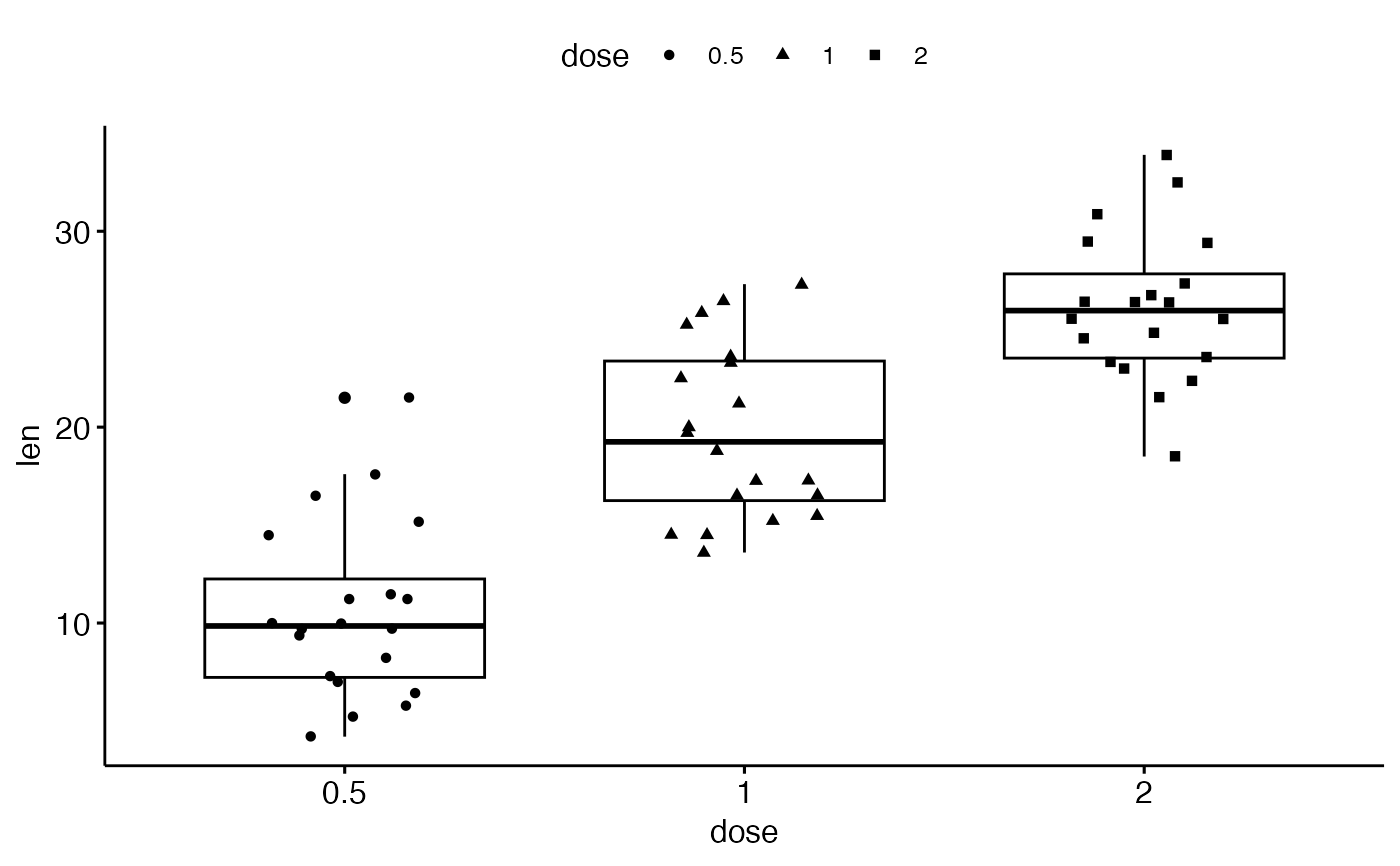 # Add violin + mean_sd
ggstripchart(df, x = "dose", y = "len",
shape = "dose", add = c("violin", "mean_sd"))
# Add violin + mean_sd
ggstripchart(df, x = "dose", y = "len",
shape = "dose", add = c("violin", "mean_sd"))
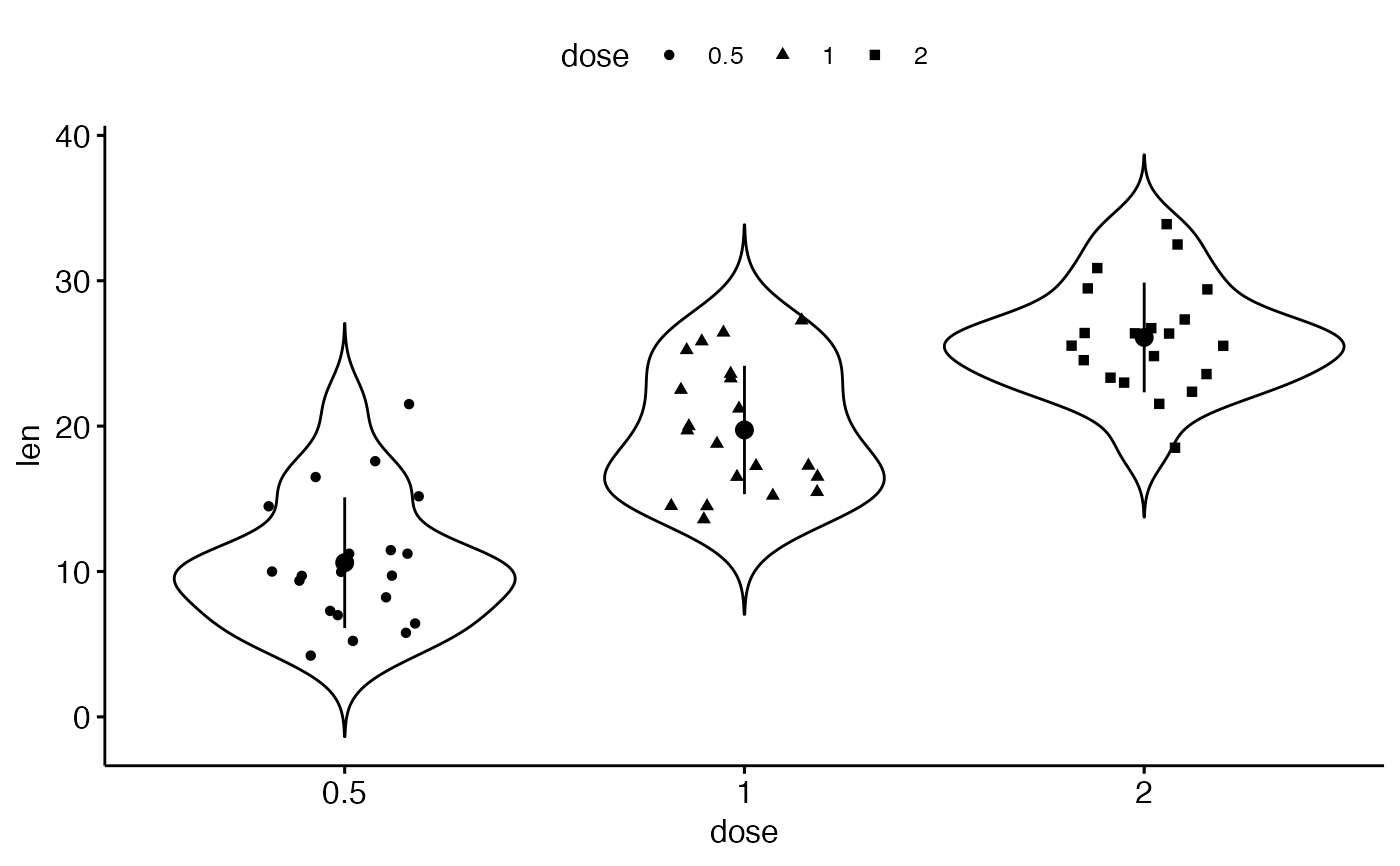 # Change colors
# +++++++++++++++++++++++++++
# Change colors by groups: dose
# Use custom color palette
ggstripchart(df, "dose", "len", shape = "dose",
color = "dose", palette = c("#00AFBB", "#E7B800", "#FC4E07"),
add = "mean_sd")
# Change colors
# +++++++++++++++++++++++++++
# Change colors by groups: dose
# Use custom color palette
ggstripchart(df, "dose", "len", shape = "dose",
color = "dose", palette = c("#00AFBB", "#E7B800", "#FC4E07"),
add = "mean_sd")
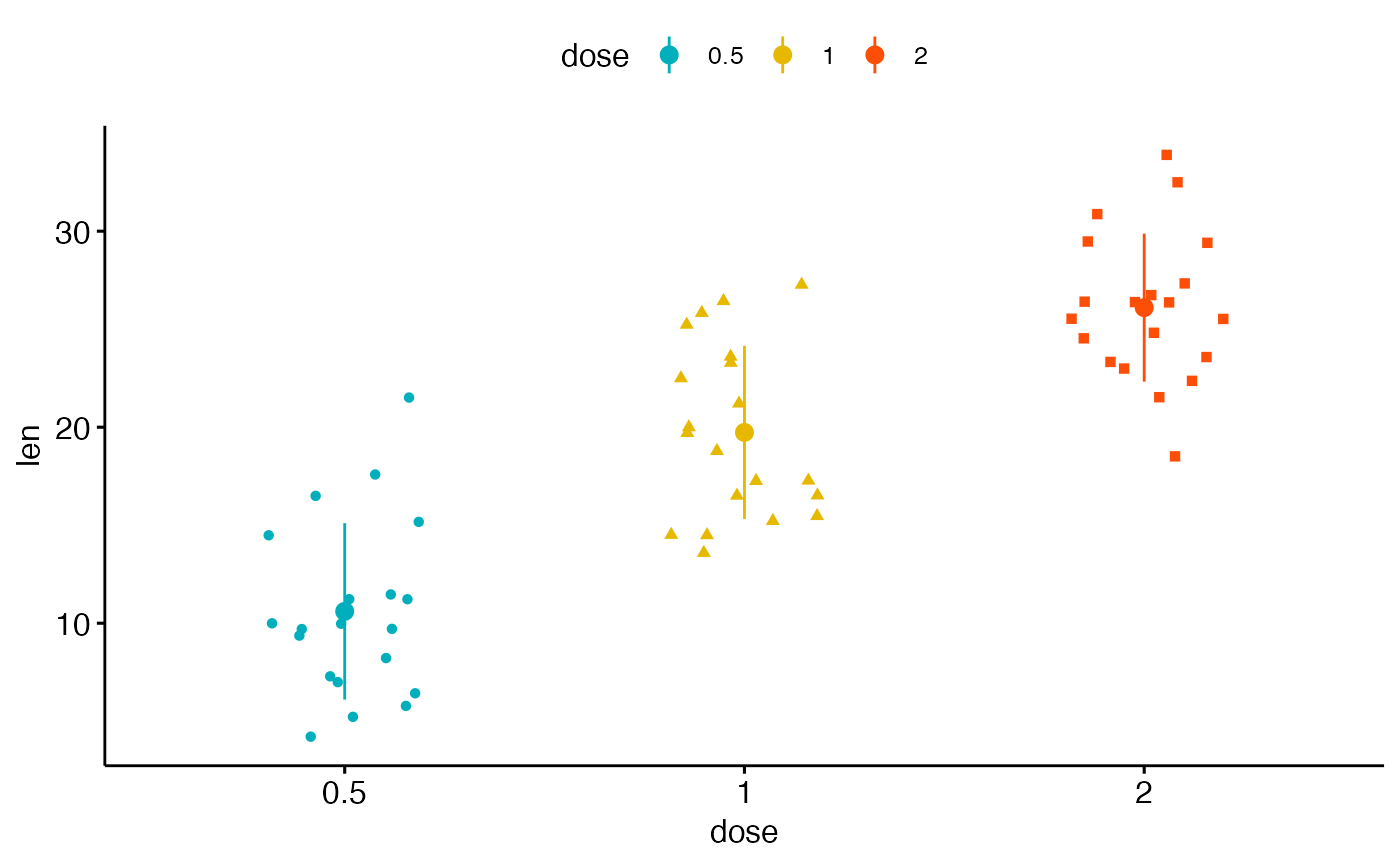 # Plot with multiple groups
# +++++++++++++++++++++
# Change shape and color by a second group : "supp"
ggstripchart(df, "dose", "len", shape = "supp",
color = "supp", palette = c("#00AFBB", "#E7B800"))
# Plot with multiple groups
# +++++++++++++++++++++
# Change shape and color by a second group : "supp"
ggstripchart(df, "dose", "len", shape = "supp",
color = "supp", palette = c("#00AFBB", "#E7B800"))
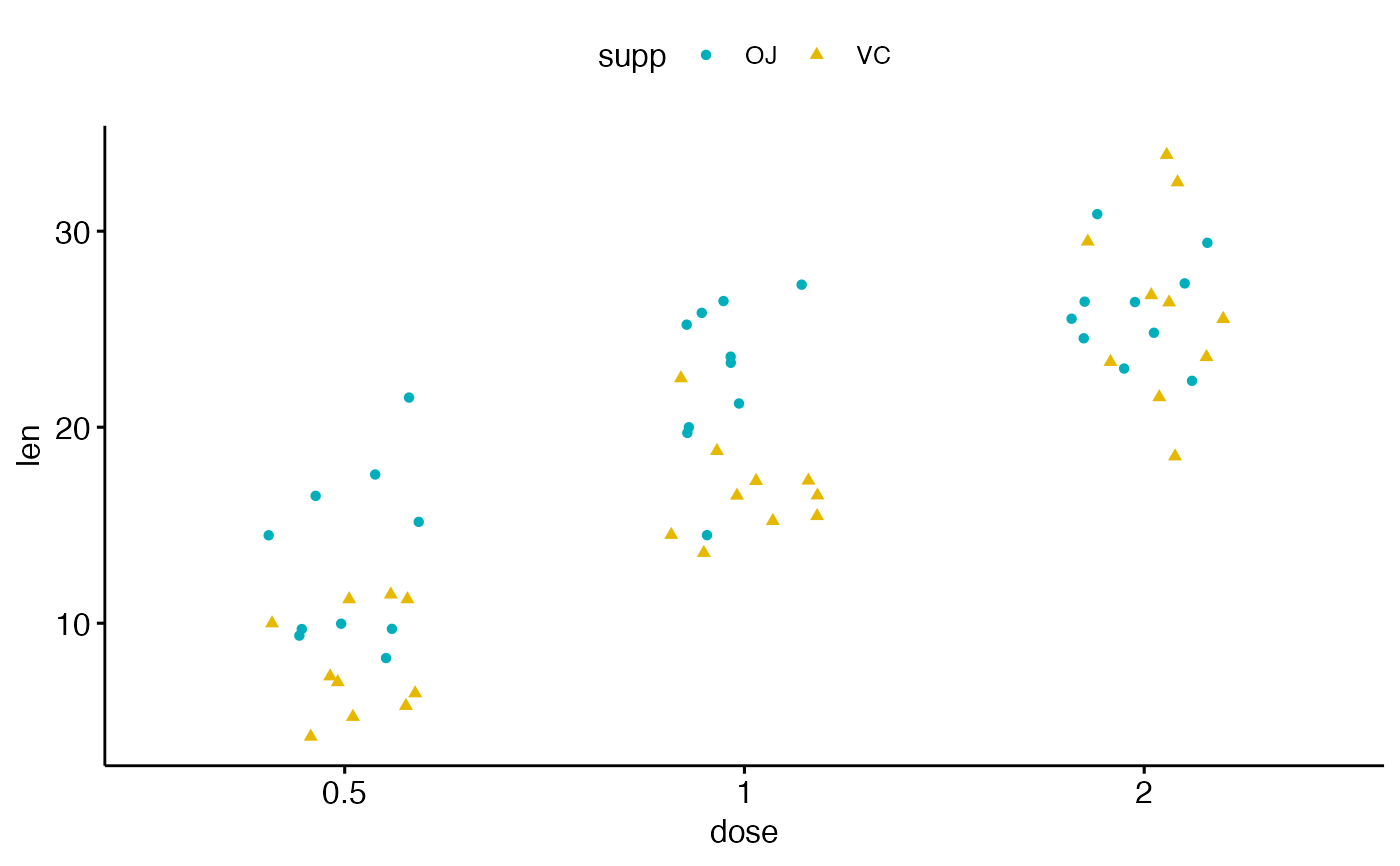 # Adjust point position
ggstripchart(df, "dose", "len", shape = "supp",
color = "supp", palette = c("#00AFBB", "#E7B800"),
position = position_dodge(0.8) )
# Adjust point position
ggstripchart(df, "dose", "len", shape = "supp",
color = "supp", palette = c("#00AFBB", "#E7B800"),
position = position_dodge(0.8) )
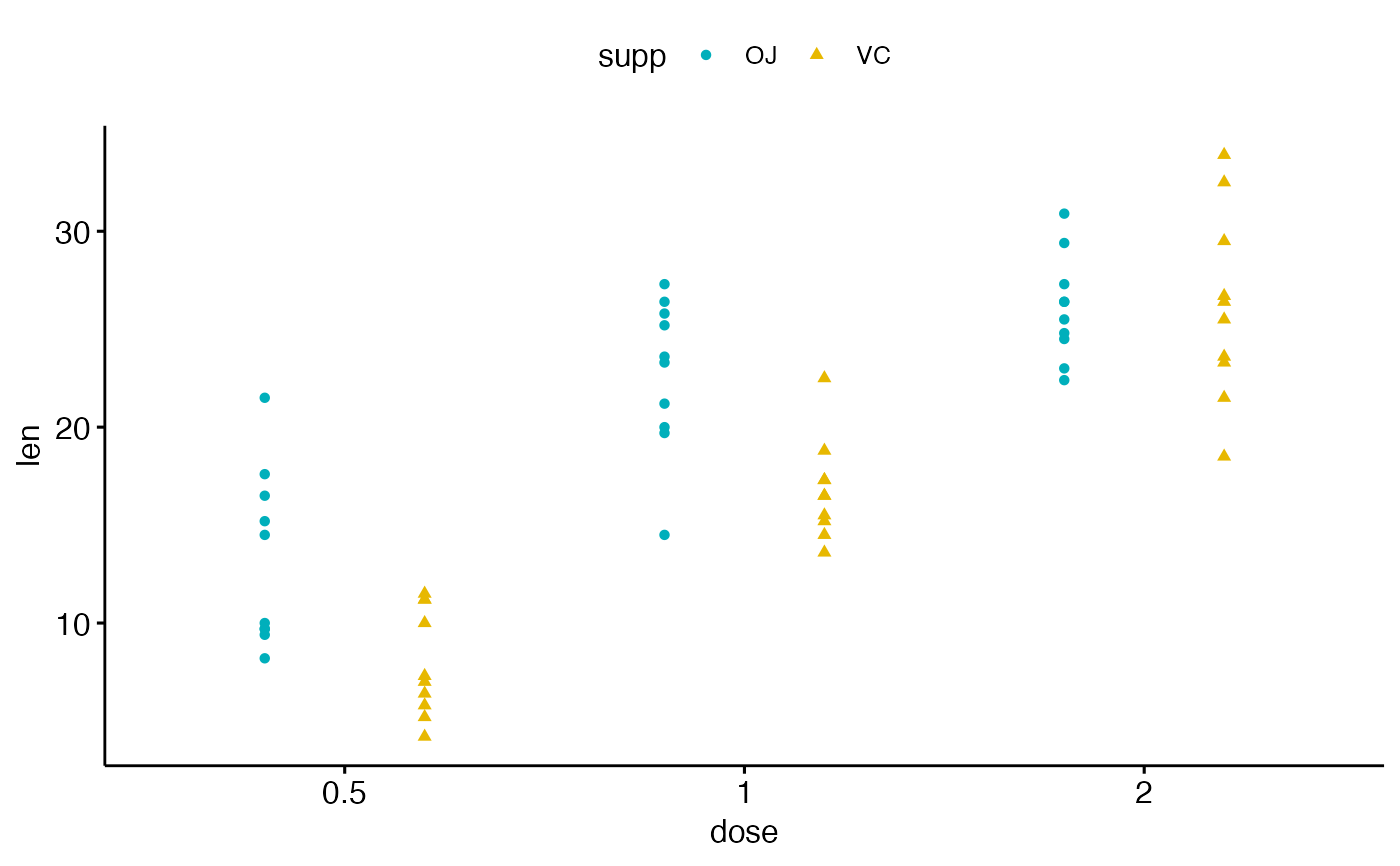 # You can also use position_jitterdodge()
# but fill aesthetic is required
ggstripchart(df, "dose", "len", shape = "supp",
color = "supp", palette = c("#00AFBB", "#E7B800"),
position = position_jitterdodge() )
# You can also use position_jitterdodge()
# but fill aesthetic is required
ggstripchart(df, "dose", "len", shape = "supp",
color = "supp", palette = c("#00AFBB", "#E7B800"),
position = position_jitterdodge() )
 # Add boxplot
ggstripchart(df, "dose", "len", shape = "supp",
color = "supp", palette = c("#00AFBB", "#E7B800"),
add = "boxplot", add.params = list(color = "black") )
# Add boxplot
ggstripchart(df, "dose", "len", shape = "supp",
color = "supp", palette = c("#00AFBB", "#E7B800"),
add = "boxplot", add.params = list(color = "black") )
